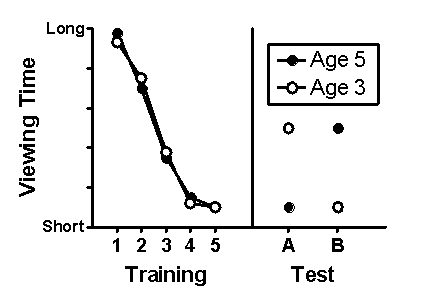Scenario I
Scenario I is based on and presents fabricated results consistent with the following study:
Kim, I. K., & Spelke, E. S. (1992) . Infants' sensitivity to effects of gravity on visual object motion. Journal of Experimental Psychology: Human Perception and Performance, 18(2) , 385-393.
Kim and Spelke (1992) investigated the extent to which infants have expectancies of gravitational effects on visual object motion. Three- and five-month-old infants repeatedly watched a video of a ball accelerating as it rolled down an incline until they spent little time actively looking at it. Subsequently, two types of test trials were conducted in randomized order. Type A test trials consisted of a ball slowing down as it rolled up an incline. Type B test trials consisted of a ball slowing down as it rolled down an incline. During all trials, the amount of time looking at each visual display was recorded. Fabricated data consistent with the major finding of this study are presented in Figure 11.1.
Figure 11.1 
-(Scenario I) Based on the data shown in Figure 11.1, which group(s) of infants, if any, appear to possess a concept of gravity?
Definitions:
Solution
The value or values that satisfy an equation, inequality, or system of equations.
Absolute Value
The distance of a number from zero on the number line, disregarding whether it is positive or negative.
Set Notation
A system of symbols and terminology used to define and describe sets and their relationships in mathematics.
Absolute Value Inequality
An inequality that involves the absolute value of a variable or expression, comparing it to a number.
Q9: (Scenario II) In the Gopnik and Astington
Q12: Children who were breastfed tend to have
Q16: Which statement regarding the number of middle-level
Q19: Defense mechanisms are _ because they _.<br>A)negative;
Q29: Jeffrey Gray's ideas on arousability include the
Q58: The quality of attachment between child and
Q65: Highly intelligent people _ than those who
Q74: Thurstone's primary mental abilities correspond to middle-level
Q94: Freud thought people went through a series
Q146: The Strange Situation test measures a child's:<br>A)problem-solving